Week 4
Online/in-Person Graduate course, University of California, Riverside, Department of Physics and Astronomy, 2019
The Foundation of Applied Machine Learning
Spring 2019
Instructor: Prof. Bahram Mobasher
Teaching Assistance: Abtin Shahidi email abtin.shahidi–at–email.ucr.edu
Course webpage: https://abtinshahidi.github.io/teaching/2019-spring-foundation-machine-learning
« Go to Week 3
Go to Week 5 »
Week 4
Continuing on Statistics: Confidence Intervals
In the following exercise we are going to learn how to find a confidence interval for the parameter estimations we learned in the past few weeks:
Let’s look at the following Normal distribution:
\[\begin{equation*} N(x; \mu, \sigma) = \frac{1}{\sqrt{2\pi\sigma^2}}\exp{-\frac{(x-\mu)^2}{2\sigma^2}} \end{equation*}\]def Gaussian(x, mu=0, sigma=1):
from math import sqrt, pi, exp
return (1/sqrt(2*pi*sigma**2)*exp(-(x-mu)**2/(2*sigma**2)))
We can generate a random number from this distributions using random package:
import random
import numpy as np
mu = 10
sigma = 3
number_of_points = int(10e5)
our_pool = np.array([random.gauss(mu, sigma) for _ in range(number_of_points)])
Now that we generated $10^5$ points from the $N(x; \mu=10, \sigma=3)$, let’s take a look at their histogram to see whether we are getting close to the Normal distribution. But first let’s import and setup the configuration of our plots as follows:
import matplotlib.pyplot as plt
# use LaTeX fonts in the plot
plt.rc('text', usetex=True)
plt.rc('font', family='serif')
Now that we have all the needed packages, let’s plot:
plt.subplots(1,1, figsize=(7,7))
plt.hist(our_pool, histtype="bar", bins=50)
plt.title(r"\textbf{Histogram for our sampled set}", fontsize=20)
plt.ylabel(r"Number count", fontsize=18)
plt.xlabel(r"x", fontsize=18)
###
x_span = np.linspace(-5,25, 10000)
y_gaussian = [Gaussian(x, mu, sigma) for x in x_span]
plt.subplots(1,1, figsize=(7,7))
a = plt.hist(our_pool, histtype="bar", density=True, bins=50)
plt.plot(x_span, y_gaussian, 'r', label=r"Gaussian with $\mu={}$ and $\sigma={}$".format(mu, sigma))
plt.title(r"\textbf{Histogram for our sampled set}", fontsize=20)
plt.ylabel(r"Weight (Normalized)", fontsize=18)
plt.xlabel(r"x", fontsize=18)
plt.legend(fontsize=10)
plt.show()

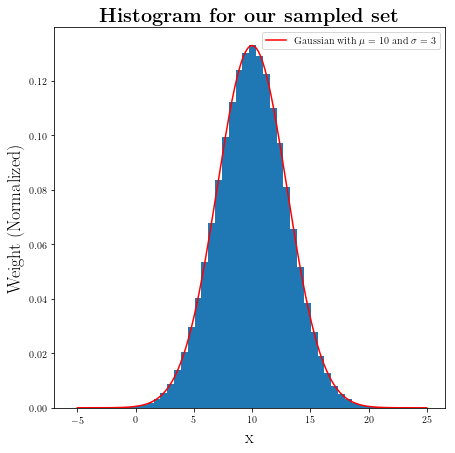
Which as you can see is fairly close to the Normal distribution.
How many of these points fall inside $[\mu-\sigma, \mu+\sigma]$?
points_inside = our_pool[our_pool<=mu+sigma]
points_inside = points_inside[points_inside>=mu-sigma]
print(r"Fraction of points inside [μ-σ, μ+σ] is:", len(points_inside)/number_of_points)
Fraction of points inside [μ-σ, μ+σ] is: 0.681943
What about $[\mu-2\sigma, \mu+2\sigma]$?
points_inside = our_pool[our_pool<=mu+2*sigma]
points_inside = points_inside[points_inside>=mu-2*sigma]
print(r"Fraction of points inside [μ-2σ, μ+2σ] is:", len(points_inside)/number_of_points)
Fraction of points inside [μ-2σ, μ+2σ] is: 0.954603
As we saw in the examples above about 68% of the points sampled from a Gaussian distributions fall within 1 $\sigma$ of the mean ($\mu$) and about 95% fall within the $2\sigma$.
Let’s use another useful library: scipy
import scipy.integrate as integral
def find_confidence(number_of_trials=1, list_of_deviations=[1, 2, 3]):
for i in range(number_of_trials):
mu = random.randint(-10, 10)
sigma = random.randint(1, 10)
print("μ =", mu, "σ =", sigma, "\n")
for j in list_of_deviations:
_integral_, _integral_err = integral.quad(Gaussian, mu-j*sigma,
mu+j*sigma, (mu, sigma))
print("Fraction of points within {} σ is :".format(j), round(_integral_,7))
print("Error in our estimation: ", _integral_err)
print("\n")
find_confidence()
μ = 10 σ = 7
Fraction of points within 1 σ is : 0.6826895
Error in our estimation: 7.579375928402476e-15
Fraction of points within 2 σ is : 0.9544997
Error in our estimation: 1.8403572258862486e-11
Fraction of points within 3 σ is : 0.9973002
Error in our estimation: 1.1072256503105314e-14
find_confidence(2,[1,2,3,4,5])
μ = -10 σ = 7
Fraction of points within 1 σ is : 0.6826895
Error in our estimation: 7.579375928402476e-15
Fraction of points within 2 σ is : 0.9544997
Error in our estimation: 1.8403572258862486e-11
Fraction of points within 3 σ is : 0.9973002
Error in our estimation: 1.1072256503105314e-14
Fraction of points within 4 σ is : 0.9999367
Error in our estimation: 4.8388942592431095e-12
Fraction of points within 5 σ is : 0.9999994
Error in our estimation: 8.668320644611427e-10
μ = 0 σ = 6
Fraction of points within 1 σ is : 0.6826895
Error in our estimation: 7.579375928402476e-15
Fraction of points within 2 σ is : 0.9544997
Error in our estimation: 1.840354865397235e-11
Fraction of points within 3 σ is : 0.9973002
Error in our estimation: 1.1072256503105314e-14
Fraction of points within 4 σ is : 0.9999367
Error in our estimation: 4.838904125482879e-12
Fraction of points within 5 σ is : 0.9999994
Error in our estimation: 8.668319950722037e-10
Additional
Let’s find the Cumulative distribution function (cdf) for a given pdf:
This is a uniform pdf:
def pdf(x, x_range=[-1,1]):
x_0 = min(x_range)
x_1 = max(x_range)
if x>=x_0 and x < x_1:
return 1/(x_1-x_0)
else:
return 0
span_X = np.linspace(-3,3,1000)
span_Y = np.array([pdf(x) for x in span_X])
plt.plot(span_X, span_Y)
plt.show()
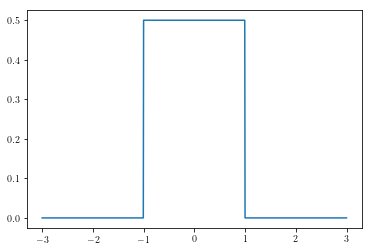
In the following we first define a function that takes integral: (not optimized much better to use buit-in functions)
def integrate(f, x0, x1, num=10**4):
_range_ = np.linspace(x0, x1, num)
_fun_val = np.array([f(x) for x in _range_])
_sum_ = 0
for i in range(num-1):
y1 = _fun_val[i]
y2 = _fun_val[i+1]
y = (y1 + y2)/2
_sum_+=y*((x1-x0)/num)
return _sum_
def cdf_finder(f, x_range):
def cdf(x):
return integrate(f, min(x_range), x)
return cdf
my_cdf = cdf_finder(pdf, [-3,3])
# Can take a while depend on your machine
y=[my_cdf(x) for x in np.linspace(-2,2, 100)]
plt.plot(np.linspace(-2,2, 100), y)
[<matplotlib.lines.Line2D at 0x7fe8727dfbe0>]
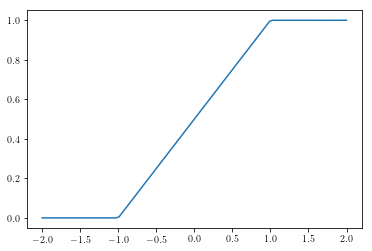
def find_x(pdf, _y_, _range_):
from scipy import optimize
def f(x):
return pdf(x)-_y_
f = np.vectorize(f)
x_range = optimize.root(f, _range_)
x_range = x_range.x
try:
return x_range[0], x_range[1]
except IndexError:
return x_range[0], x_range[0]
def confidence(pdf, fraction, precision, _range_):
num = 10000
_x_span = np.linspace(min(_range_), max(_range_), num)
_y_span = np.vectorize(pdf)(_x_span)
_y_ = max(_y_span)
_y_copy = _y_
step = min([1e-4, precision])
_integral_ = 0
error_=[]
while abs(_integral_-fraction)>=precision:
_y_ -= step
x0, x1 = find_x(pdf, _y_, _range_)
_integral_, err = integral.quad(pdf, x0, x1)
error_.append(abs(_integral_-fraction))
assert _y_>=0
return (x0, x1), _integral_, error_
def Normal(x):
return Gaussian(x,100,2)
x0, _integ_, _err_= confidence(Normal, 0.95, 0.001, [95,105])
x0
(96.09564867116791, 103.90435132882638)
_integ_
0.949082647612146
def generic_pdf(x):
return x*(1-x)
def normalized(x):
n, _ = integral.quad(generic_pdf, 0, 1)
return generic_pdf(x)/n
_x0_, intg, _er = confidence(normalized, 0.68, 0.001, [0,1])
_x0_
(0.2537277878234768, 0.7462722122178391)
figure = plt.figure(figsize=(8,8))
_X_ = np.linspace(0, 1, 1000)
plt.plot(_X_, normalized(_X_))
plt.plot(_x0_[0]*np.ones(100), np.linspace(0, normalized(_x0_[0]), 100), 'r')
plt.plot(_x0_[1]*np.ones(100), np.linspace(0, normalized(_x0_[1]), 100), 'r')
[<matplotlib.lines.Line2D at 0x7f31240a4390>]
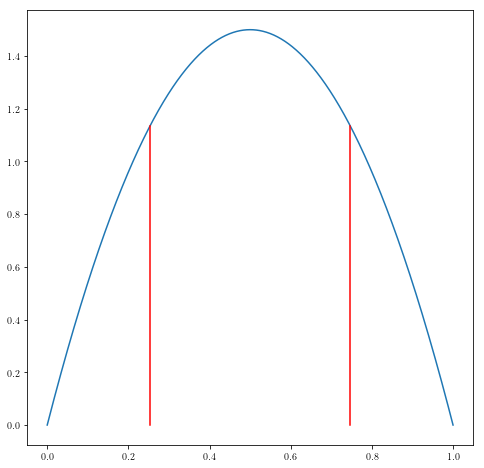
Finding the best fit for the line:
_a_ = 1
_b_ = 0
x_data = np.arange(1, 10, 1)
y_data = np.array([_a_*x+_b_+ random.gauss(0, 0.5) for x in x_data])
fig = plt.figure(figsize=(8,8))
plt.plot(x_data, y_data, ".")
plt.ylabel(r"y", fontsize=18)
plt.xlabel(r"x", fontsize=18)
Text(0.5, 0, 'x')

What is our model?
\[\begin{equation*} y = f(x) = \alpha x + \beta \end{equation*}\]num = 100
α_span = np.tan(np.linspace(0, np.pi/2, 100))
β_span = np.linspace(-3, 3, 100)
def least_squared(data, prediction):
diff = (data-prediction)**2
return sum(diff)
_matrix_err_ = np.zeros((num, num))
for i in range(num):
for j in range(num):
prediction = α_span[i]*x_data+β_span[j]
_matrix_err_[i][j] = least_squared(y_data, prediction)
ij_min = np.where(_matrix_err_ == _matrix_err_.min())
our_best_estimate = (α_span[ij_min[0]], β_span[ij_min[1]])
our_best_estimate
(array([10.4724738]), array([-3.]))
fig2 = plt.figure(figsize=(8,8))
plt.plot(x_data, y_data, ".", label="Our data")
plt.plot(x_data, our_best_estimate[0]*x_data+our_best_estimate[1],
label="Our model: ${}x+{}$".format(round(float(our_best_estimate[0]),3),
round(float(our_best_estimate[1]), 3)))
plt.ylabel(r"y", fontsize=18)
plt.xlabel(r"x", fontsize=18)
plt.legend()
plt.show()
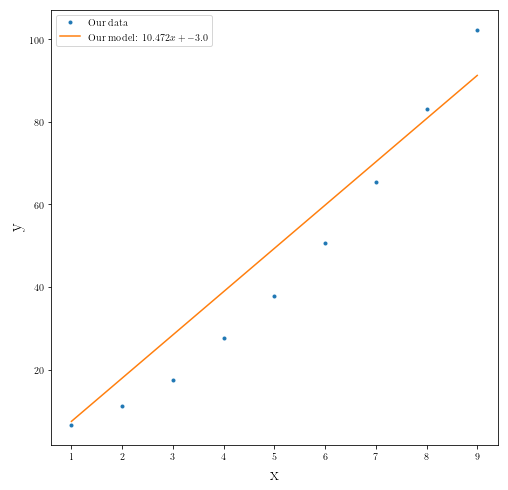
Let’s fit higher degrees!
Fitting model for a data set taken from the second-order polynomial added by a random Gaussian noise:
_a_ = 1
_b_ = 2
_c_ = 3
x_data = np.arange(1, 10, 1)
y_data = np.array([_a_*x**2+_b_*x+_c_+ random.gauss(0, 0.5) for x in x_data])
fig = plt.figure(figsize=(8,8))
plt.plot(x_data, y_data, ".", markersize = 12)
plt.ylabel(r"y", fontsize=18)
plt.xlabel(r"x", fontsize=18)
plt.show()
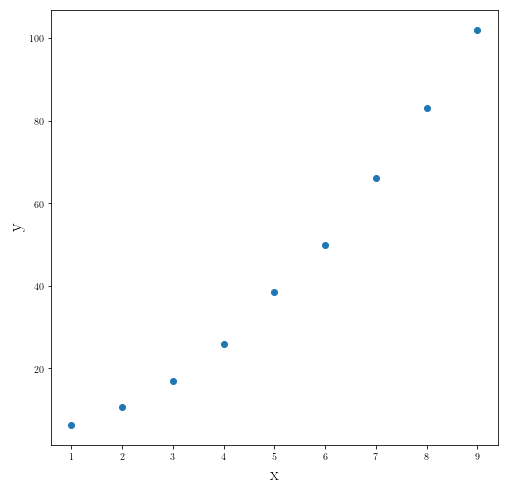
Let’s fit the linear model first, then we can move on to the higher orders.
num = 1000
α_span = np.tan(np.linspace(0, np.pi/2, 1000))
β_span = np.linspace(-20, 20, 1000)
_matrix_err_ = np.zeros((num, num))
for i in range(num):
for j in range(num):
prediction = α_span[i]*x_data+β_span[j]
_matrix_err_[i][j] = least_squared(y_data, prediction)
ij_min = np.where(_matrix_err_ == _matrix_err_.min())
our_best_estimate_linear = (α_span[ij_min[0]], β_span[ij_min[1]])
########
fig2 = plt.figure(figsize=(8,8))
plt.plot(x_data, y_data, ".", label="Our data")
plt.plot(x_data, our_best_estimate_linear[0]*x_data+our_best_estimate_linear[1],
label="Our model: ${}x+{}$".format(round(float(our_best_estimate_linear[0]),3),
round(float(our_best_estimate_linear[1]), 3)))
plt.ylabel(r"y", fontsize=21)
plt.xlabel(r"x", fontsize=21)
plt.legend(fontsize=19)
plt.show()
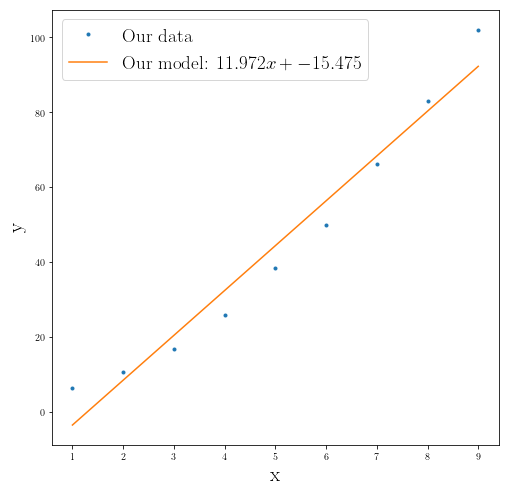
Fitting second order polynomial
Now let’s use the exact same grid search algorithm for the second order polynomial.
num = 100
α_span = np.linspace(0, 3, num)
β_span = np.linspace(-3, 3, num)
γ_span = np.linspace(0, 5, num)
_matrix_err_ = np.zeros((num, num, num))
for i in range(num):
for j in range(num):
for k in range(num):
prediction = α_span[i]*x_data**2 + β_span[j]*x_data + γ_span[k]
_matrix_err_[i][j][k] = least_squared(y_data, prediction)
ijk_min = np.where(_matrix_err_ == _matrix_err_.min())
our_best_estimate = (α_span[ijk_min[0]], β_span[ijk_min[1]], γ_span[ijk_min[2]])
our_best_estimate
(array([1.]), array([2.03030303]), array([2.97979798]))
fig2 = plt.figure(figsize=(8,8))
plt.plot(x_data, y_data, ".", label="Our data")
plt.plot(x_data, our_best_estimate_linear[0]*x_data+our_best_estimate_linear[1],
label="Our model: ${}x+{}$".format(round(float(our_best_estimate_linear[0]),3),
round(float(our_best_estimate_linear[1]), 3)))
plt.plot(x_data, our_best_estimate[0]*x_data**2+our_best_estimate[1]*x_data+our_best_estimate[2],
label="Our model: ${}x^2+{}x+{}$".format(round(float(our_best_estimate[0]),3),
round(float(our_best_estimate[1]), 3),
round(float(our_best_estimate[2]), 3)))
plt.ylabel(r"y", fontsize=18)
plt.xlabel(r"x", fontsize=18)
plt.legend(fontsize=14)
plt.show()
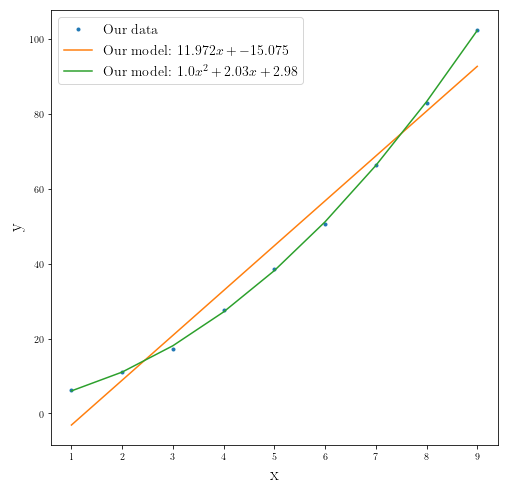
Using numpy.polyfit(x, y, deg) built-in function:
np.polyfit(x_data, y_data, deg=1)
array([ 12.02979301, -15.36805287])
np.polyfit(x_data, y_data, deg=2)
array([1.01031624, 1.92663061, 3.15441153])
fig2 = plt.figure(figsize=(8,8))
plt.plot(x_data, y_data, ".", label="Our data")
plt.plot(x_data, our_best_estimate_linear[0]*x_data+our_best_estimate_linear[1],
label="Our model: ${}x+{}$".format(round(float(our_best_estimate_linear[0]),3),
round(float(our_best_estimate_linear[1]), 3)))
plt.plot(x_data, our_best_estimate[0]*x_data**2+our_best_estimate[1]*x_data+our_best_estimate[2],
label="Our model: ${}x^2+{}x+{}$".format(round(float(our_best_estimate[0]),3),
round(float(our_best_estimate[1]), 3),
round(float(our_best_estimate[2]), 3)))
plt.ylabel(r"y", fontsize=18)
plt.xlabel(r"x", fontsize=18)
plt.legend(fontsize=14)
plt.show()

Let’s find a measure which accounts for how much of the variability of the measured data has been included in our model.
This is called coefficient of determination:
\[\begin{equation*} R^2 = 1 -\frac{\sum_i(y_i - p_i)^2}{\sum_i(y_i - \mu)^2} \end{equation*}\]In which ${y_i}$ are the measured values, ${p_i}$ are the predicted values from our model and $\mu$ is mean of measured values.
Let’s turn the above formula into a code:
def R_squared(measured, prediction, mean_squared=False):
"""
R^2 function:
What portion of the variability in the data is captured
you are using is accurately predicting the observed data.
BEWARE:
This is not a measure for being the true model
since you can always get a polynomial of order n
to fit your n data point perfectly no matter the
value of the data points.
So you should beware of over-fitting data by adding
unnecessary parameters into our model.
INPUT:
* measured (list, numpy.array): contains empirical data
* prediction (list, numpy.array): contains prediction
from your model.
OUTPUT:
* R (float) = 1-(sum (measured-prediction)^2)/
(sum (measured-mean_measured)^2)
* mean_error (float): Mean of the errors
* standard deviation (float) within the measured values
"""
error = sum((np.array(measured)-np.array(prediction))**2)
std = sum((np.array(measured)-np.mean(measured))**2)
mean_error = error/len(measured)
if mean_squared:
return 1 - error/std, mean_error, std/len(measured)
else:
return 1 - error/std
A general fitting function using scipy:
We are going to pass the values for which we want to fit and a list of degrees of the polynomials you want to fit. And it will return an array of the coefficients sorted by the highest order. And we are going to plot the result for several degrees.
def general_fit(_x_values, _y_values, list_of_degrees=[1]):
model=[]
for degree in list_of_degrees:
fit = np.polyfit(_x_values, _y_values, deg=degree)
model.append(fit)
return model
def plot_fits_data(x_values, y_values, list_of_degrees=[1]):
fitting_parameters = general_fit(x_values, y_values, list_of_degrees)
x_span = np.linspace(min(x_values), 1.1*max(x_values), 100)
i= 0
plt.plot(x_values, y_values, '.', label="Data ")
for fit_par in fitting_parameters:
reg = R_squared(y_values, np.polyval(fit_par, x_values))
reg = round(reg, 3)
y = np.polyval(fit_par, x_span)
try:
plt.plot(x_span, y, label="Degree {}: $R^2={}$".format(list_of_degrees[i],reg))
except IndexError:
break
i+=1
plt.legend(fontsize=14)
_x_, _y_=[0, 1, 2, 3, 4], [1, 2.2, 19, 34.33, 40.1]
fig = plt.figure(figsize=(8,8))
plot_fits_data(_x_, _y_, [1,2,3,4,5])
plt.title(r"Fitting polynomials", fontsize=22)
plt.legend(fontsize=17)
plt.xlabel(r"X axis", fontsize=17)
plt.ylabel(r"Y axis", fontsize=17)
plt.show()
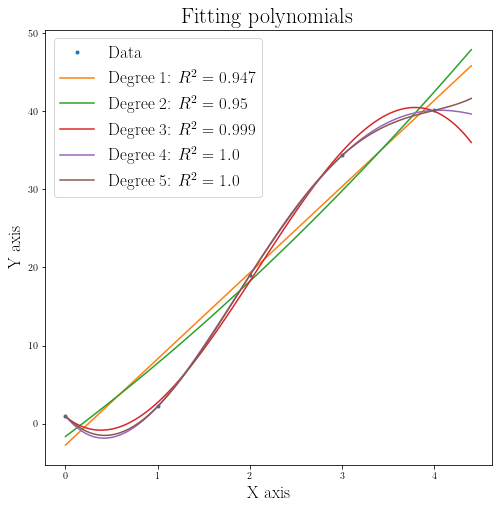
As you can see by adding more parameters to our parameter space our fit gets better and better in including variability in our data.
However, this does not mean that we have a better model. For seeing why, just imagine any given set of data points ${(x,y)}$. ($n+1$ data points) My argument is that I can solve for the coefficient of the following polynomial (given our data) which will force the polynomial to go through all of the given data points, in other words it has $R^2=1$:
\[\begin{equation*} y = P(x) = a_n x^n + a_{n-1}x^{n-1}+...+a_1 x + a_0 \end{equation*}\]If you put your data points $(n+1)$ inside this polynomial you can have $n$ independent parameters for the set of $n$ linear equations which can be solved. So there is a solution for the best fitting parameters.
For example for 3 data points we have: ${(0,0),(1,2), (2,3)}$
If my previous statement is valid I should be able to fit a “perfect” model with $n=2$ polynomial:
\[\begin{equation*} y = P(x) = a_2 x^2+a_1 x + a_0 \end{equation*}\]So we can form these set by inputting our data:
\[\begin{equation*} a_0 = 0 \qquad & a_1 + a_2 = 2 \qquad 4 a_2 + 2 a_1= 3 \end{equation*}\]Which leads to:
\[\begin{equation*} a_0 = 0 \quad a_1= \frac{5}{2} \quad a_2 = -\frac{1}{2} \end{equation*}\]So the following polynomial is going to be the “perfect” fit. But you can guess something is not right. Since we are adding extra complexity to our models which is not necessarily gives us the right direction to go for finding the “true” underlying model which can be quite simple and because of the random errors we see more data variability. So there is this trade off which you should consider whenever you add more complexity and this case increasing the degree of polynomials to better fit the data.
This is our model function that perfectly predict the given values: \(\begin{equation*} y = -\frac{1}{2} x^2 + \frac{5}{2} x \end{equation*}\)
def g(x): return 5/2*x -1/2 *x**2
print((0, g(0)),(1, g(1)), (2, g(2)))
(0, 0.0) (1, 2.0) (2, 3.0)
